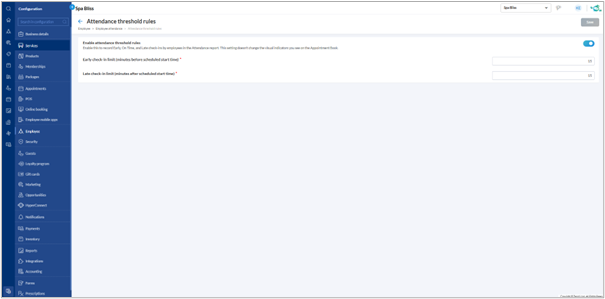Standardize early and late check-ins using attendance threshold rules
This article explains how businesses can use Attendance Threshold Rules to define what qualifies as an "Early," "On Time," or "Late" check-in for employees. With these rules, organizations can standardize attendance tracking based on their internal definitions of punctuality.
Overview
Different organizations follow different standards when it comes to evaluating employee punctuality.
These configurations help HR teams and management gain uniform insights into employee attendance, ensuring that reported data aligns with internal expectations. Attendance classification using these rules is reflected only in the Attendance Details report, enabling accurate performance analysis without altering any visual indicators in the Appointment Book or other Zenoti modules.
Example: Let’s say an employee is scheduled to start work at 9:00 AM. The company has set:
Early Check-in Limit: 15 minutes
Late Check-in Limit: 15 minutes
So,
Check-ins before 8:45 AM are marked as Early
Check-ins between 8:45–9:15 AM are marked as On Time
Check-ins after 9:15 AM are marked as Late
The classification appears in a new column called Attendance Status in the Attendance Details report.
Set threshold rules at the organization level
Go to Configurations > Employee > Employee Attendance > Attendance Threshold Rules.
Switch on the Enable attendance threshold rules toggle.
Set your preferred check-in limits:
Early Check-in Limit: The number of minutes prior to the scheduled start time that a check-in is considered early.
Late Check-in Limit: The number of minutes after the scheduled start time that a check-in is considered late.

Click Save.
Configure rules at the center level
Navigate to Configuration > Employee > Attendance Threshold Rules at the center level.
Choose one of the following:
Use organization default – Organization level rules are applied.
Override at center level – Lets you define center-specific early and late check-in limits.
If you are overriding the organization level settings:
Enter the new values as needed.
Optionally, enable the Disable attendance threshold rules for this center setting to skip using this feature for your center.
Limitations
These threshold rules apply only to the Attendance Details report.
These theshold rules do not affect real-time or visual indicators in the Appointment Book or other modules of Zenoti.
Impact on reports
After you configure attendance thresholds:
The Attendance Details report displays two new columns:
Actual – Schedule: Difference between the first check-in time and the scheduled start
Check-in Status: Status based on threshold evaluation (Early, On Time, Late)
Note
These columns are visible only when you filter by View by Date. These columns are not displayed by default. You must enable these columns from the report configuration settings.

The system uses the first scheduled shift and the first check-in of the day to calculate the difference. This calculation is shown in the Actual – Schedule column, regardless of how many shifts or check-ins the employee has that day.